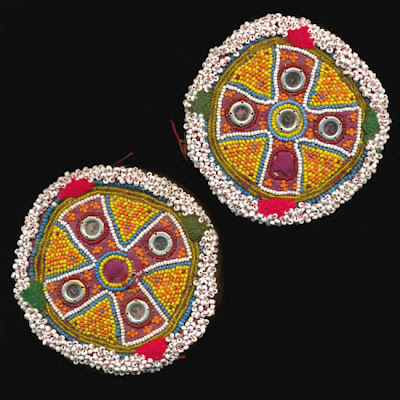 |
| Beaded medallions from Afghanistan |
Beadwork has played an important part in decoration and ceremony in Afghanistan since very ancient times. There are many different cultural groups who live in the region that is now divided into Afghanistan, Pakistan, northern Iran and Turkmenistan. These peoples were mostly nomadic, now tending to stay in one area because of warfare, strife and political unrest. However decoration, protection and tribal identification remain very important and beadwork is still an art form in most of these areas.
The round beaded medallions that many dancers have incorporated into their costuming are traditionally called gul-i-peron or beaded ‘gul’. They are made on small circular pieces of felt or leather decorated with seed beads, shells, mirrors, etc. and attached to dresses, bags, animal harness and many other items. Gul and other beadwork are found almost anywhere there is space for adornment and come in an infinite variety of sizes and more recently a variety of shapes. Usually made in traditional colors and patterns, they are still produced by hand today.
Lots of examples of Kuchi beadwork are listed at The Red Camel in the beadwork category.
For more information, see:
Harvey,Janet (1996)Traditional Textiles of Central Asia. London: Thames and Hudson.
Kalter,Johannes (1983)The Arts and Crafts of Turkestan. London: Thames and Hudson.


